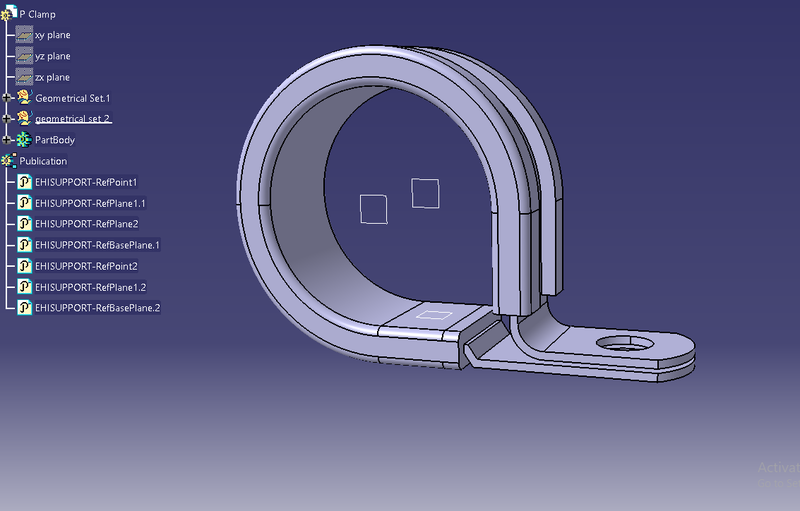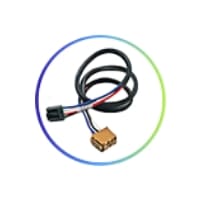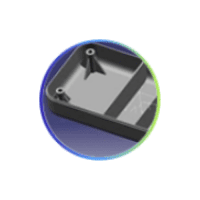Courses by Software
Courses by Semester
Courses by Domain
Tool-focused Courses
Machine learning
POPULAR COURSES
Success Stories
Project 1
AIM Route the Wiring harness on Given Engine and Prepare flatten view drawing in CATIA V5. Application of all Packaging rules, Industry best practices studied in this course shall be demonstrated in design. Apply Protection coverings as required. ENGINE WIRING HARNESS ROUTING …
Karthik S
updated on 23 May 2023
AIM
Route the Wiring harness on Given Engine and Prepare flatten view drawing in CATIA V5. Application of all Packaging rules, Industry best practices studied in this course shall be demonstrated in design. Apply Protection coverings as required.
ENGINE WIRING HARNESS ROUTING

fig.1. Given V16 engine
The above figure shows the given V16 engine cad data .Here routing the wiring harness for the following electrical components attached to the engine.
- fuel injector for each cylinder we have 16 cylinder engine
- camshaft sensors on each engine block (4 camshaft sensor )
- Engine coolant sensor at the centre of the engine between the two blocks
- Engine oil temperature and oil pressure sensor fitted at the oil sump of the engine on both engine cylinder blocks
- sensors for sense neutral positon of the transmission assembly and measure the vehicle speed
- Interconnection connector to connect engine harness system to vehicle harness system.
Harness mounting and routing management required to provide proper packaging of the wiring harness.it also deals with clearance management and manufacturability
- P-clamps to provide positive clamping and proper clearance management for the routing
- Mounting clips for connector mounting
- Guiding channels provide thermal protection in high temperature zones .
- Corrugated tubes used to protect the wiring harness from hazardous liquids and temperature
Next create a new product in assembly workbench named as assembly wiring harness contex .it is the top level product file inside this product file created geometrical bundle and wire harness electrical bundle.Given V16 engine cad data added inside this contex assembly.
Geometrical bundle contains all of the harness components i.e connectors ,clip, gromets and actual physical bundle segments and branches.All the components should be defined electrically .
Download the 3d data of required connectors and mountings from the site www.te.com
- define the connectors electrically by defining all its properties shown in the below fig.

fig.2.Inter connection connector

fig.2.connector 2 pole

fig.3.connector 2 pole

fig.4. connector 4 pole (injection system )
open the cad data of connectors in catia part design workbench and create the connector connection point,connector connection axis system , bundle connection point .Then Switch to electrical part design workbench and define it as a connector also define connector connection point and bundle connection point.
Here we have inter connection connector it require mounting clip for mounting the connector .so cavity connection point should be defined for this connector.
All the connectors defined as electrical connector and defined all the necessary properties to Connectors.Created a catalog document in connector family and stored all the connector data in catalog document .

fig.5.connector catalog document
download the other harness mountings like clips and clamps cad data.Also download the brackets for parking the interconnection connectorand channel for routing the harness in high temperature zones
Mounting clip
- define the mounting clip electrically by defining all the properties .
Define the clip as mounting equipment using mounting equipment command. Select cavity command and define the parameters.

fig.6.mounting clip for interconnection connector
P-Clamp
First define geometrical parameters such as entry point, entry plane, exit point, exit plane and base plane .Then switch to electrical part design workbench and define the P-clamps as support using support command and define the parameters.

fig.7.P-clamp
Fur tree clip
First define geometrical parameters such as entry point, entry plane, exit point, exit plane and base plane .Then switch to electrical part design workbench and define the fur-tree clip as support using support command and define the parameters.

Fig.8 fur-tree clip
Plastic guiding channels
The given V-16 engine has 8 injectors both on the left and right side of the engine which are close to one another, so plastic guiding channel is used for trouble free routing of the wiring harness inaddition it provide thermal protection from high temperature zones of the engine.
First create geometrical parameters such as bundle entry points, and external reference line in the part design workbench to route the wiring harness into the guiding channel trhen define the guiding channel as a electrical part by using the define equipment option .define all the properties to the channel .


Fig.9. plastic guiding channel
sheet metal bracket
Add sheet metal bracket in order to provide parking for the interconnection connector. Also, we have to make sure that the bracket is placed inside the context assembly and outside of engine and geometrical bundle assembly.

fig.10. sheet metal bracket
- Add all the electrically defined components to the geometrical bundle.place the components at proper location for routing the harness
- Then switch into the electrical harness assembly workbench and Geometrical bundle product file should be electrically defined using the Define Geometrical bundle option .
Harness routing and packaging
- The available connectors are added into the geometrical bundle and properly positioned onto the fuel injectors, camshaft sensors, vehicle speed sensor, neutral position sensor and engine coolant sensor.manipulation tool is used to place the connectors.

fig.11.connectors
- Here we have one interconnection connector to connect engine harness system to vehicle harness system.so it required additional parking provision.Existing bolt on the engine is used to mount the sheet metal bracket. The bracket should be provided with a suitable locking feature in clockwise direction.first mount the clip on the sheet metal bracket .Then the interconnection connector is electrically connected with the mounting clip by using connect electrical devices command in the electrical assembly design workbench.

fig.12.properly parked the electrically connected interconnection connector and mounting clip on the sheetmetal bracket
Adding supporting components like p-clamps and fir-tree clip . P-Clamps are mounted on the existing bolts and screws to provide positive clamping and ensure proper clearance management for the wiring harness routing and also help to prevent the harness fouling from unwanted mechanical components.
- P - Clamp and the Fir Tree can be placed at appropriate location and ensure clearance management.
- The p – Clamps can be mounted to the existing holes provided on the Engine block in which the screws to tighten the Engine block.
- After finalization of the routing, request the Engine design team to provide the threaded holes for fix the Fir tree clips as per their location.

fig.13.p-clamps and fir-tree clip positioned on engine
- Add guiding channel for routing the wiring harness to the fuel injectors.it deals with clearance management and thermal protection of the wiring harness in the high temperature zones.Then request engine design team to provide additional threaded holes required to mount the guiding channels in proper location by using bolts or screws .

fig.14. guiding channel
After define the geometrical bundlel electrically, Then select the multibranchable command to start the bundle routing and click on the route definition.
The bundle routing starts from interconnection connector and then to the P-clamps and to the guiding channels. Adding branche points to route the wiring harness from main branch to various connectors.
To route the wiring harness through the guiding channels select external curve option and click on the line created in the guiding channel.then add branch points to route the wiring herness from the guiding channel to the connectors .proper bend radius and slack provided for the bundle segment to avoid stress on the wire.


fig.15. wiring harness routing
- Add protective coverings on the wiring harness to protect wiring from high temperature . protective covering created by using define protection part command in the electrical part design workbench. Select part , and define the parameters as per the requirement.
- The created corrugated tube can be added into the catalog by store device command and selecting the catalog file created for protective covering. then appropriate protective covering added to the bundle segments.

fig.16.final wiring harness
-
After routing the harness then check the bundle Continuity .
Edit⮕Search⮕Advanced⮕Electrical Workbench⮕Type:-Bundle Segment⮕Attribute:-Fully Connected.Selecting the "TRUE" option in the attribute criterion it will show all the connected bundle segmen

fig.17.bundle continuity
design criteria followed to route the wiring harness
- Wiring harness routed by considering the factors ease in manufacturing, accessibility, easy removal and easy maintenance of attached equipments and routing harness.
- Wiring harness should be routed in such a way that it is easy to assemble on a vehicle.
- Wiring harness should be kept away from sharp environments like sheet metal brackets, panel edges, corners etc.
- Avoid harness routing and clipping in blind zone of operator during harness during installation.
- Ensure that routing meets the clearance requirements with the different surrounding parts.
- Routing shall provide enough slack for each branch to avoid additional stress on wire and terminal crimping joints but ensure that extra slack does not cause wiring harness foul with surrounding parts and impact desired clearance requirements.
- Enough clamps should be provided to ensure the positive clearance with surrounding and safety of wiring harness.
- Use of plastic guided channels are recommended to meet the clearances in critical areas if it is difficult to achieve by use of clamps.
- Branch length should be minimum 50mm.
- Minimum distance between clip and nearest branching point should be 25mm.
- Minimum distance between two breakouts should be 50mm.
- Limit the no. of branches from single branch point upto 4.
- Ensure that harness protection is provided according to surrounding temperature, manufacturabilty and expected reliability.
- The min. bend radius is to be 1.4.
WIRING HARNESS FLATTENING
Create a new product file for flatten the wiring harness and save as in the same folder where the wiring harness is saved. Then switch to Electrical harness flattening workbench and select harness flattening parameters and define harness flattening parameters. Before creating flatten view, Make sure that selecting 'Double line' for bundle segment and 'Double' line for protective covering.


fig.18.flattening parameters
while flattening the engine harness it pop-up a software error .it is due to some software issue so iam using the stp file for drawing .


drawing of the flattened wiring harness
open a new drawing file and Select front view command, then go to the flattened harness window and select a suitable face to create drafting of the harness.
to make the bundle segments visible right click on the drawing sheet and go to properties, in the view tab, highlight '3D wireframe' and 'is always visible' in the dress up settings.

fig.20. Harness flatten drawing
Leave a comment
Thanks for choosing to leave a comment. Please keep in mind that all the comments are moderated as per our comment policy, and your email will not be published for privacy reasons. Please leave a personal & meaningful conversation.
Other comments...
Be the first to add a comment
Read more Projects by Karthik S (27)
Project 2
AUTOMOTIVE WIRING HARNESS BACKDOOR Statement of assignment: Route the Wiring harness on Given car body and Prepare flatten view drawing in CATIA V5. Application of all Packaging rules, Industry best practices studied in this course shall be demonstrated in design. Apply Protection coverings as required. Available connector…
24 May 2023 03:20 PM IST
Project 1
AIM Route the Wiring harness on Given Engine and Prepare flatten view drawing in CATIA V5. Application of all Packaging rules, Industry best practices studied in this course shall be demonstrated in design. Apply Protection coverings as required. ENGINE WIRING HARNESS ROUTING …
23 May 2023 03:27 PM IST
Wiring harness design in CATIA V5 - 3D modeling Week 7 Challenge
AIM: TO FLATTEN THE WIRING HARNESS AND DRAFT THE WIRING HARNESS ASSEMBLY. GIVEN: HARNESS ASSEMBLY: HARNESS FLATTENING: WE GO TO THE HARNESS FLATTENING WORKBENCH AND DEFINE THE FLATTENING PARAMETERS. WE USE THE EXTRACT COMMAND TO BRING THE HARNESS ASSEMBLY TO THE FLATTENING WORKBENCH HERE. CHOOSING A SUITABLE PLANE WE FLATTEN…
13 May 2023 09:10 AM IST
Wiring harness design in CATIA V5 - 3D modeling Week 5 & 6 Challenge
modelling Week 5 & 6 Challenge Aim: Route two electrical harnesses per the given layout and interconnect them as a single harness assembly check for bundle continuity, and bundle warnings, and then provide annotations for the final harness assembly. Objective: The objective of this project is to first route the two Harness…
12 May 2023 08:28 AM IST
Related Courses


Skill-Lync offers industry relevant advanced engineering courses for engineering students by partnering with industry experts.
Our Company
4th Floor, BLOCK-B, Velachery - Tambaram Main Rd, Ram Nagar South, Madipakkam, Chennai, Tamil Nadu 600042.
Top Individual Courses
Top PG Programs
Skill-Lync Plus
Trending Blogs
© 2025 Skill-Lync Inc. All Rights Reserved.










